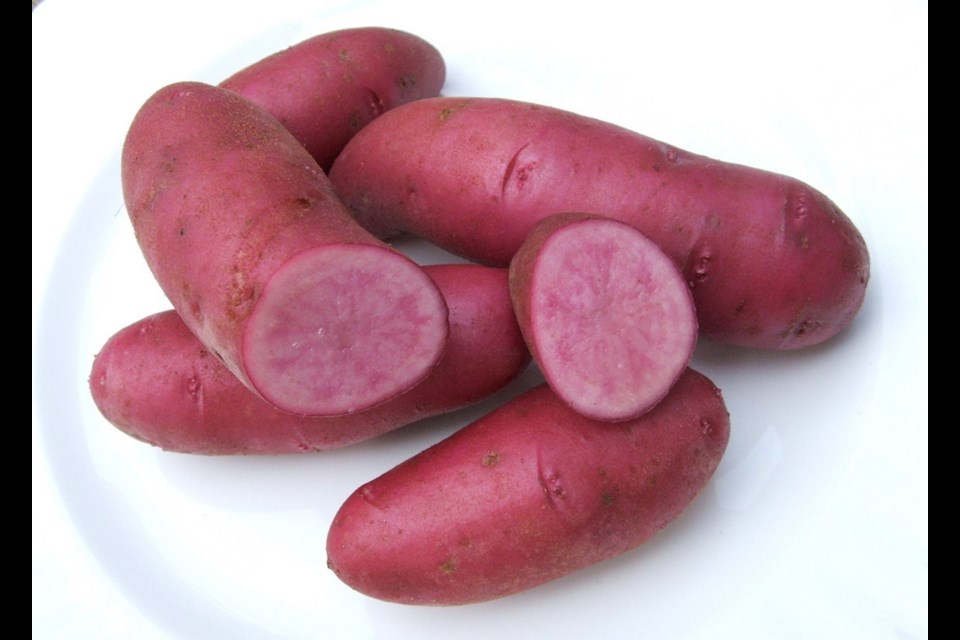Dear Helen: What is the best potato for growing in a limited space?
W.D.
I don’t know of any potato that has markedly space-saving plants, but for a limited area I suggest you choose among the most high-yielding plants that produce the type of potato you like best.
Would you prefer to grow an all-purpose, white-fleshed potato good for baking, roasting, steaming and mashing? Among these, Kennebec is the most reliably high yielding in my experience. Some outlets will also carry the new ‘Classic Russet,’ also considered a “very high-yield” potato.
At garden centres soon you’ll also find “gourmet” potatoes. Some have purple or red flesh. Some are a “fingerling” shape. One high-yielding fingerling with yellow skin and flesh and a buttery taste is ‘Bellanita.’
The red-fleshed ‘AmaRosa’, a small, elongated potato with pinkish-red flesh, has produced very well for me in confined spaces. It is delicious halved and roasted with a drizzle of oil. Russian Blue produces large potatoes with purple-blue flesh. They make beautifully coloured mashed potatoes.
Many people are extraordinarily fond of Sieglinde, which is also referred to as German butter potato. Its tubers are smooth, oblong, and yellow-skinned. It is known for its creamy taste and high yields.
Dear Helen: My amaryllis bulb produced a series of three thick flower stems. All of them bore absolutely gorgeous bloom clusters. My concern is that no leaves appeared with the flower stems. Is the bulb worth keeping for bloom again next winter?
C.N.
Some amaryllis bulbs don’t produce leaves until after the bloom period. Others grow leaves at the same time as the flower stems. In either case, preparation for next year’s flowers should begin as soon as the last of this year’s flowers have faded. The goal is to re-plump the bulb to give it the energy to form one or more embryonic flower buds.
First, remove the faded flower clusters. This is to prevent them from forming seeds — a further stress on the bulb. It’s traditional to cut the stems off right above the top of the bulbs, but if you don’t mind the unsightliness of the stems’ meltdown, leave them to help revitalize the bulb as they die back.
Move the plant to a bright window, and begin fertilizing with your preferred house plant food, every two weeks at half the recommended label strength. Bright light, coolish room temperatures, feeding and regular watering will foster ample growth of dark green leaves as the bulb rebuilds.
If possible, move the plant outdoors for the summer, but wait until early July, after the danger of narcissus fly infestation has passed. The larvae of this pest burrow inside target bulbs and feed there, ruining the bulbs.
Keep the plant watered in the summer, but stop fertilizing in August. In the fall, before frost, bring the plant back indoors to a sunny window and cool temperatures. Reduce watering enough to keep the soil mix just slightly dry.
Depending on the bulb variety, the leaves may yellow and dry off on their own. In that case, cut them away once they have withered and store the bulb in a cool place. Water very occasionally, just to keep the bulb from drying out. If the leaves remain green, keep the plant as a regular house plant over the winter.
Watch for a flower bud nosing through the bulb top. This could happen at any time between January and March. At that point, you can replace a top layer of soil mix with fresh. Make sure the pot is at the brightest window possible, at room temperatures, and resume regular watering. This is also the time for repotting, which is needed only every two or three years.
GARDEN EVENTS
Dahlia meeting. Victoria Dahlia Society will meet on Thursday, 7:30 p.m. in the Victorian at McKenzie, 4000 Douglas St. The evening’s program will be Waking Up Your Tubers and Preparing for Spring. Visitors are welcome.
Seedy in Courtenay. The Comox Valley Growers & Seed Savers will host Seedy Saturday on Saturday in the Florence Filberg Centre, 411 Anderton Ave. in Courtenay. The event will feature vendors, listed at cvgss.org, Master Gardeners to answer questions, a Seedy Café, and speakers. Fiona Chambers will describe A Plethora of Perfect Potatoes and Arzeena Hamir will offer tips on keeping fresh green vegetables on the table year round. Doors open at 10 a.m. and close at 3 p.m. Admission $5, free after 2 p.m.



